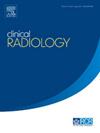基于超声的ADNEX模型鉴别良性、交界性和恶性卵巢上皮肿瘤。
IF 2.1
3区 医学
Q2 RADIOLOGY, NUCLEAR MEDICINE & MEDICAL IMAGING
引用次数: 0
摘要
背景:本研究的目的是评估国际卵巢肿瘤分析-附件中不同肿瘤的评估(IOTA-ADNEX)模型区分良性、交界性和恶性上皮性卵巢肿瘤(分别为BeEOTs、BEOTs和MEOTs)的能力。方法:813例BeEOTs、beot和meot患者均行超声检查和盆腔手术。比较三组患者的临床资料及超声特征,以组织病理学诊断为金标准。计算ADNEX模型的敏感性、特异性、阳性预测值、阴性预测值和受试者工作特征曲线下面积(AUC)。结果:这是一项单中心回顾性研究。813例患者中,257例(31.6%)有beot, 114例(14.0%)有beot, 442例(54.4%)有meot。对于确定卵巢癌(OC)总风险的临界值为10%,敏感性和特异性分别为99.1%和73.2%。根据受试者工作特征曲线,BeEOTs与MEOTs的AUC为0.987 (95% CI: 0.981-0.993), BeEOTs与BEOTs的AUC为0.820 (95% CI: 0.768-0.872), BeEOTs与I期OC的AUC为0.912 (95% CI: 0.876-0.948), BeEOTs与II-IV期OC的AUC为0.995 (95% CI: 0.992-0.998)。与I期OC相比,BEOTs的AUC为0.614 (95% CI: 0.519-0.709),与II-IV期OC相比,BEOTs的AUC为0.903 (95% CI: 0.869-0.937),与II-IV期OC相比,I期OC的AUC为0.851 (95% CI: 0.800-0.902)。结论:IOTA-ADNEX模型对三种类型的附件肿块均有较好的诊断效果,在辅助放射科医师评估附件肿块方面具有推广应用的潜力。本文章由计算机程序翻译,如有差异,请以英文原文为准。
Ultrasound-based ADNEX model for differentiating between benign, borderline, and malignant epithelial ovarian tumours
Background
The purpose of this study was to evaluate the ability of the International Ovarian Tumor Analysis-Assessment of Different NEoplasias in the adneXa (IOTA-ADNEX) model to distinguish among benign, borderline, and malignant epithelial ovarian tumours (BeEOTs, BEOTs, and MEOTs, respectively).
Methods
The study included 813 patients with BeEOTs, BEOTs, and MEOTs who underwent ultrasound examinations and pelvic operations. Comparisons were made between the clinical information and ultrasonographic features of the three patient groups, and the histopathological diagnosis was the gold standard. The sensitivity, specificity, positive predictive value, negative predictive value, and area under the receiver operating characteristic curve (AUC) of the ADNEX model were calculated.
Results
This was a single-centre retrospective study. Of the 813 patients, 257 (31.6%) had BeEOTs, 114 (14.0%) had BEOTs, and 442 (54.4%) had MEOTs. For a cut-off value of 10% to identify the overall risk for ovarian cancer (OC), the sensitivity and specificity were 99.1% and 73.2%, respectively. According to the receiver operating characteristicscurves, the AUC was 0.987 (95% CI: 0.981-0.993) for BeEOTs compared with MEOTs, 0.820 (95% CI: 0.768-0.872) for BeEOTs compared with BEOTs, 0.912 (95% CI: 0.876-0.948) for BeEOTs compared with stage I OC, and 0.995 (95% CI: 0.992-0.998) for BeEOTs compared with stages II-IV OC. The AUC was 0.614 (95% CI: 0.519-0.709) for BEOTs compared with stage I OC, 0.903 (95% CI: 0.869-0.937) for BEOTs compared with stages II-IV OC, and 0.851 (95% CI: 0.800-0.902) for stage I OC compared with stages II-IV OC.
Conclusions
The IOTA-ADNEX model demonstrated good diagnostic performance for the three categories of EOTs and may have the potential to be popularised in assisting radiologists in the assessment of adnexal masses in the future.
求助全文
通过发布文献求助,成功后即可免费获取论文全文。
去求助
来源期刊

Clinical radiology
医学-核医学
CiteScore
4.70
自引率
3.80%
发文量
528
审稿时长
76 days
期刊介绍:
Clinical Radiology is published by Elsevier on behalf of The Royal College of Radiologists. Clinical Radiology is an International Journal bringing you original research, editorials and review articles on all aspects of diagnostic imaging, including:
• Computed tomography
• Magnetic resonance imaging
• Ultrasonography
• Digital radiology
• Interventional radiology
• Radiography
• Nuclear medicine
Papers on radiological protection, quality assurance, audit in radiology and matters relating to radiological training and education are also included. In addition, each issue contains correspondence, book reviews and notices of forthcoming events.
 求助内容:
求助内容: 应助结果提醒方式:
应助结果提醒方式:


